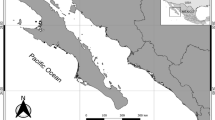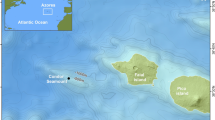Abstract
Tuna, like most large pelagic fish, are highly exploited by man, and it is, therefore, important to determine mercury (Hg) levels in these species in order to establish allowable limits for their consumption and/or contamination levels in the environment. In this study, we evaluated Hg accumulation in yellowfin tuna (Thunnus albacares) muscle in two different geographic sites of the eastern Pacific Ocean. There was a positive association between Hg content and tuna size in the equatorial zone (EQZ). Using adjusted sizes, the site of origin was a determinant factor in Hg accumulation. Sex, by contrast, did not affect Hg levels, suggesting that males and females have similar feeding habits. No Hg concentration was over the Hg content thresholds for large marine predators adopted by Mexican norms and by North American authorities (1 μg g−1 w.w.). Hg input due to yellowfin tuna consumption represented from 9.84% to 35.87% in Baja California Sur and from 14.78% to 53.87% in EQZ of the provisional tolerable weekly intake adopted by the World Health Organization. The target hazard quotient for Hg was <1 in each group of the population studied, which indicates that consumption of yellowfin tuna is not a threat to human health.





Similar content being viewed by others
References
Wiener JG, Krabbenhoft DP, Heinz GH, Scheuhammer AM (2003) Ecotoxicology of mercury. In: Hoffman DJ, Ratter BA, Burton GAJ, Cairns JJ (eds) Handbook of ecotoxicology, CRC-LLC, 2nd edn. Lewis Publishers, Boca Raton, pp 409–463
Secretaría de Medio Ambiente, Recursos Naturales y Pesca, (SEMARNAP) (1996) Lo que usted debe saber sobre el mercurio y su situación en Americana del Norte. Serie Mercurio no. 1, Instituto Nacional de Ecología, México D.F., pp 1–11
Berlin CM Jr, Kacew S, Lawrence R, LaKind JS, Campbell R (2002) Criteria for chemical selection for programs on human milk surveillance and research for environmental chemicals. J Toxicol Environ Health 65:1839–1851
Consejo Mexicano para la Promoción de Productos Pesqueros y Acuícolas AC (COMEPESCA) (2005) http://www.comepesca.com.mx. Accessed October 2010
Boush GM, Thieleke JR (1983) Total mercury content in yellowfin and bigeye tuna. Bull Environ Contam Toxicol 30:291–297
Storelli MM, Giacominelli-Stuffler R, Storelli A, Marcotrigiano GO (2005) Accumulation of mercury, cadmium, lead and arsenic in swordfish and bluefin tuna from the Mediterranean Sea: a comparative study. Marin Pollut Bull 50:993–1018
Storelli MM (2008) Potential human health risks from metals (Hg, Cd, and Pb) and polychlorinated biphenyls (PCBs) via seafood consumption: estimation of target hazard quotients (THQs) and toxic equivalents (TEQs). Food Chem Toxicol 46:2782–2788
Bloom NS (1992) On the chemical form of mercury in edible fish and marine invertebrate tissue. Can J Fish Aquat Sci 49:1010–1017
Food and Agricultura/World Health Organization (FAO/WHO) (1972) Evaluation of certain food additives and the contaminants mercury, cadmium and lead. FAO/WHO Technical report series no. 505. FAO/WHO, Genova
IPCS (1987) Principle for safety assessment of food additives and contaminants in food. Technical report. International programme on chemical safety in cooperation with the Joint FAO/WHO Expert Committee on Food Additives (JECFA)
Environmental Protection Agency (U.S. EPA) (1994) Guidance for assessing chemical contaminant data for use in fish advisories. Risk assessment and fish consumption limits. Technical report. Office of Water, U.S. Environmental Protection Agency, Philadelphia
Dreyfus-León M, Robles-Ruiz H, Ulloa-Ramírez PA (2000) Pesquería del atún en el Océano Pacífico. In: Cisneros-Mata MA, Beléndez-Moreno LF, Zaráte-Becerra E, Gaspar-Dillanes MT, Lopez-González L, Saucedo-Ruiz C, Tovar-Avila J (eds) Sustentabilidad y pesca responsable en México evaluación y manejo. Instituto Nacional de Pesca (INP), Mazatlán, Sinaloa
Alonso D, Pineda P (1997) Bioacumulación y biomagnificación de mercurio en dos especies ícticas de diferente nivel trófico en la Bahía de Cartagena y la Cienega Grande de Santa Marta, Caribe Colombiano. Proyecto de grado. Universidad Jorge Tadeo Lozano, Bogotá, Colombia, p 78
Olson RJ, Watters GM (2003) A model of the pelagic ecosystem in the eastern tropical Pacific Ocean. Inter-Am Tuna Comm Bull 22(3):1–17
García-Hernández J, Cadena-Cárdenas L, Betancourt-Lozano M, García de la Parra LM, García-Rico L, Márquez-Farías F (2007) Total mercury content found in edible tissues of top predator fish from the Gulf of Califórnia, Máxico. Toxicol Environ Chem 89(3):507–522
Rasmussen RS, Nettleton J, Morrisey MT (2005) A review of mercury in seafood: special focus on tuna. J Aqua Food Prod Tech 14(4):71–100
Kojadinovic J, Potier M, Le Corre M, Cosson RP, Bustamante P (2006) Mercury content in commercial pelagic fish and its risk assessment in the Western Indian Ocean. Sci Total Environ 366(2–3):688–700
Zar JH (1999) Biostatistical analysis, 4th edn. Prentice-Hall, Upper Saddle River, pp 1–1029
Joint FAO/WHO Expert Committee on Food Additives (JECFA) (2003) Sixty-first meeting of the JECFA. Summary and conclusions. Annex 4, Rome, 10–19 June
Environmental Protection Agency (U.S. EPA) (2000) Mercury study report to congress. Office of Research and Development, Washington, DC
Environmental Protection Agency (U.S. EPA) (1997) Mercury study report to congress. Office of Research and Development, Washington, DC
Morrisey MT, Rasmussen R, Okada T (2004) Mercury content in Pacific troll-caught albacore tuna (Thunnus alalunga) during the 2003 seson. J Aqua Food Prod Tech 13(4):41–52
Inter-American Tropical Tuna Commission (I-ATTC) (1990) Quarterly report of the Inter-American Tropical Tuna Commission. Quart Rep I-ATTC 2:5–6
Honda K, Tatsukawa R, Itano K, Miyazaki N, Fujiyama T (1983) Heavy metal concentrations in muscle, liver and kidney tissue of Striped Dolphin, Stenellacoeruleoalba, and their variations with body length, weight, age and sex. Agric Biol Chem 47(6):1219–1228
Johnels AG, Westermark T (1969) Mercury contamination of the environment in Sweden. In: Miller MWy, Berg GG (eds) Chemical fallout: current research of persistent pesticides. Charles C. Thomas, Springfield, pp 221–241
Galván MF (1988) Composición y análisis de la dieta del atún aleta amarilla Thunnus albacares en el Océano Pacífico Mexicano durante el período 1984–1985. Tesis de Maestría, CICIMAR-IPN., La Paz, B.C.S., México, p 86
Alatorre V (2007) Hábitos alimenticios del atún aleta amarilla Thunnus albacares y barrilete Katsuwonus pelamis en cardúmenes mixtos del Océano Pacífico Oriental Tropical. Tesis de Maestría, Centro Interdisciplinario de Ciencias Marinas, IPN., La Paz, B.C.S., México, p 86
Goldberg ED (1975) Marine pollution. In: Skirrow Ry (ed) Chemical oceanography. Academic, London
Mason RPy, Fitzgerald WF (1990) Alkylmercury species in the equatorial Pacific. Nature 347:457–459
Maz A, López C (2006) Biomagnificación y bioacumulación de mercurio en cuatro especies de tiburón de la península de Baja California Sur, México. Tesis de licenciatura, Universidad Jorge Tadeo Lozano, Bogotá, Colombia, p 77
Hall JE (2002) Bioconcentration, bioacumulation and biomagnification in Puget Sound Biota: assessing the ecological risk of chemical contaminants in Puget Sound. University of Washington Tacoma. Available at: http://courses.washington.edu/uwtjuelissues. Accessed November 2010
WHO (1995) Methylmercury environmental health criteria. World Health Organization, Geneve
Menasveta P, Siriyong R (1977) Mercury content of several predacious fish in the Andaman Sea. Mar Pollut Bull 8(9):200–203
Krapiel AML, Keller K, Chin HB, Malcolm EG, Morel FMM (2003) Sources and variations of mercury in tuna. Environ Sci Technol 37:5551–5518
Mattews AD (1983) Mercury content of comercial important fish of the Seychelles, and hair mercury levels of a selected part of the population. Environ Res 30:305–312
Adams DH (2004) Total mercury levels in tunas from offshore waters of the Florida Atlantic coast. Mar Poll Boll 49(7–8):659–663
Cai Y (2005) Bioccumulation of mercury in pelagic fishes in NW Gulf of Mexico. Ph.M. thesis, Texas A&M University, p 62
Kaneko JJ, Ralston NVC (2007) Selenium and mercury in pelagic fish in the Central North Pacific near Hawaii. Biol Trace Elem Res 119:242–254
Storelli MM, Stuffler RG, Marcotrigiano GO (2002) Total and methyl mercury residues in tuna-fish from the Mediterranean sea. Food Addit Contam 19(8):715–720
ATSDR (1999) Toxicological profile for mercury. U.S Department of Health and Human Services, Atlanta
Matsumoto H, Koya G, Takeuchi T (1965) Fetal minamata disease. J Neuropathol Exp Neurol 24:563–574
Secretaría de Salud (1995) NOM-027-SSA1-1993. Bienes y Servicios. Productos de la pesca. Pescados frescos-refrigerados y congelados. Especificaciones Sanitarias Secretaría de Salud, México, D.F.
Comisión Regulation European Community (2006) Regulation no. 1881/2006 of December 2006, setting maximun levels for certain contaminants in foodstuffs. Official J EU L364:5–24
CONAPESCA (2009) Anuario Estadístico de Acuacultura y Pesca. Capitulo III. Comercialización y consumo. Available at: www.conapesca.sagarpa.gob.mx. Accessed March 2011
Petróczi A, Naughton DP (2009) Mercury, cadmium and lead contamination in seafood: a comparative study to evaluate the usefulness of Target Hazard Quotients. Food Chem Toxicol 47(2):298–302
Cuvin-Aralar MLA, Furness RW (1991) Mercury and selenium interaction: a review. Ecotoxicol Environ Safety 21:348–364
Heinz GH, Hoffman DJ (1998) Methylmercury chloride and selenomethionine interactions on health and reproduction in mallards. Environ Toxicol Chem 17:139–145
Kaneko JJ, Ralston NVC (2007) Selenium and mercury in pelagic fish in the central North Pacific near Hawaii. Boil Trace Elem Res 119:242–254
Pelletier E (1985) Mercury-selenium interactions in aquatic organisms: a review. Mar Environ Res 18:111–132
Gather HE, Sunde MS (1974) Effect of tuna fish and selenium on the toxicity of methylmercury: a progress report. J Food Sci 39:1–5
Kai N, Ueda T, Katakoma A (1983) On mercury and selenium in tuna fish tissues. VIII. The levels of mercury and selenium in albacore from the Indian Ocean. J Shimonoseki Univ Fish 31:69–73
Acknowledgments
We thank Robert J. Olson from the Inter-American Tropical Tuna Commission for providing samples. Thanks also to Fish Ecology Laboratory from CICIMAR-IPN and Jaime Ballinas Flores from the Toxicology Laboratory of the FMVZ-UNAM. FGM thanks the Instituto Politécnico Nacional (COFAA, EDI) for grants.
Author information
Authors and Affiliations
Corresponding author
Rights and permissions
About this article
Cite this article
Ordiano-Flores, A., Galván-Magaña, F. & Rosiles-Martínez, R. Bioaccumulation of Mercury in Muscle Tissue of Yellowfin Tuna, Thunnus albacares, of the Eastern Pacific Ocean. Biol Trace Elem Res 144, 606–620 (2011). https://doi.org/10.1007/s12011-011-9136-4
Received:
Accepted:
Published:
Issue Date:
DOI: https://doi.org/10.1007/s12011-011-9136-4




